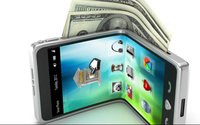Commentary
87% Of Millennials Use Mobile Banking; Security Still Top Barrier
- by Chuck Martin , Staff Writer, September 7, 2016
 Consumer expectations have both an upside and a downside for the growth of mobile payments.
Consumer expectations have both an upside and a downside for the growth of mobile payments.
We know from numerous studies that there are various barriers to masses of consumers jumping onto the mobile payments bandwagon.
While retailers have been gradually upgrading sales terminals to be able to accept various mobile payment methods, such as Apple Pay and Samsung Pay, consumers with capable phones still have been reluctant to give up paying by cash or credit card.
Banks, on the other hand, have been meeting many mobile expectations.
One recent study found that many customers are quite active and happy with mobile banking, as I wrote about here recently (78% Satisfied With Mobile Banking, While Mobile Wallet Purchases Drop).
The amount of mobile banking activity is also based partly on the demographics of the consumer, based on a new study.
It turns out that a large majority (87%) of those 18 to 35 years old already use mobile banking, according to the quarterly consumer trends survey, comprising a survey of 3,000 U.S. banking customer conducted by Harris Poll for Fiserv.
Mobile essentially is transforming the banking experience for consumers. Here are some of the ways:
- 51% -- Say mobile will change the way they bank in the future
- 44% -- Mobile has already changed the way they bank
- 41% -- Millennials who would leave their wallet at home if they could store all of the information they need in a digital wallet
The way consumers are using mobile banking also is shifting.
Previous surveys found most consumers using mobile for accessing information, such as viewing balances, statements and ATM locations, according to the Harris study. More complex tasks are being done today, such as:
- 47% -- Paying for products and services online
- 45% -- Transferring money between accounts
- 37% -- Depositing checks
The majority (71%) of millennials expect that mobile banking will transform their banking experience in the future. Some of that transformation is already happening, with more than half (56%) of those 25 to 35 years old who use mobile bill pay saying they have increased their use of the service over the last year.
For security when using a mobile app for banking, more (62%) consumers favor fingerprint technology over those (41%) who prefer a password.
Consistent with other studies, this one found security concerns to be a major barrier for more mobile banking. Of those who do not use mobile banking, here’s why:
- 64% -- Concerned about security of accessing financial information
- 35% -- Don’t use bill pay because of concerns of protecting personal information
- 29% -- Don’t do person-to-person payments due to concern of security and protecting personal information
Other expectations revolve around speed. More than a third (36%) of consumers want same-day bill paid postings and 33% want same-day transaction postings.
Another hurdle for more mobile banking is simply awareness. For example, almost half (45%) of people don’t know their financial institution’s bill pay service offers the ability to receive or view bills online and 41% don’t know their bank offers person-to-person payment options.
Mobile banking clearly is the bright spot for money moving through mobile phones.
For context, more than four in five purchases are made through point of sale and mobile wallets represent fewer than 1% of all transactions, according to a study by Bank of America.
That is growing, with mobile wallet transactions up 249% from a year ago, and millennials’ use up 267%.
So while mobile wallets represent less than a percentage of all spending, mobile banking is pulling away from the pack.



